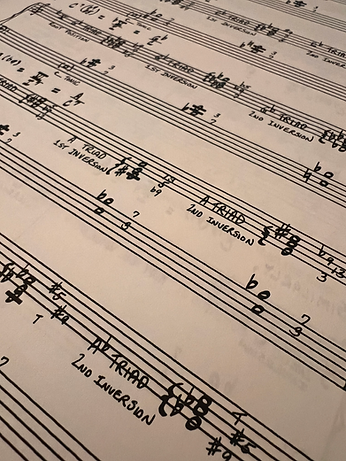
Music Theory
Welcome to the Music Theory section! Here you can find the basics of music theory including extra practice links
Includes
-
Parts of the Staff
-
Key Signatures
-
Enharmonic
-
Major Keys
-
Minor Keys
-
-
Time Signature
-
Note Values
-
-
Rhythm
-
Note Reading
Parts of the Staff
-
Clef - Indicates how to read the notes on the staff
-
Key Signature - Indicates which pitches will be raised or lowered.
-
Time Signature - Tells us how many & of what note value go into each measure.
-
Barline - Splits the staff into measures based on the time signature.
-
Measure - A segment of music that has a certain number of beats.
-
Double Barline - Two lines that indicate the end of a piece.

Notes & Rhythm
Notes vs. Rests
-
Notes are beats of sound
-
Rests are beats of silence
Time Signatures
Enharmonic - notes that are the same pitch but have a different name
ex)
-
In the chart below A# and Bb are the same pitch
Special Cases
-
B/C and E/F
Major Keys
Minor Keys

Key Signatures
Note Values
Rests
Rhythm Counting
Note Reading
Treble Clef
Lines
-
Every Good Burger Deserves Fries
Spaces
-
FACE
Easy
Medium
Hard:
Alto Clef
Lines
-
Furry Animals Can't Eat Grapes
Spaces
-
Grumpy Bats Don't Fly Away
Easy
Medium
Hard:
Bass Clef
Lines
-
Great Big Dragons Fly Away
Spaces
-
All Cows Eat Grass
Easy
Medium
Hard:
For Pianists - Both Treble & Bass Clef
Easy
Medium
Hard
Ear-Training
Modes
What is a mode?
-
"The word ‘mode’ comes from the Latin for ‘manner, or method’ but musical modes all originated in ancient Greece, so they have Greek names. The modes were named after various regions, perhaps to represent the people who lived there, because Greek musical theorists were philosophers too, and associated the arts with aspects of morality. Basically, a mode is a type of scale, as in ‘do re mi fa so la ti do’. Alter just one of those notes and you can call your scale a ‘mode’ (https://www.classicfm.com/discover-music/latest/guide-to-musical-modes)
Why do we use modes?
-
Modes help composers and musicians identify common patterns used. Various modes are famously used to play certain styles and can guide composers/musicians on how to add phrasing or how to write the next section.
Ionian = Major Scale
WWHWWWH
Aeolian = Minor Scale
WHWWHWW
Lydian = Major Scale w/Raised 4th
WWWHWWH
Mixolydian = Major Scale w/Lowered 7th
WWHWWHW
Dorian = Minor Scale w/Raised 6th
WHWWWHW
Phrygian = Minor Scale w/Lowered 2nd
HWWWHWW
Locrian = Minor Scale w/Lowered 2nd & 5th
HWWHWWW
If you play all white keys on the piano starting on C you have Ionian
Starting on:
C = Ionian
D = Dorian
E = Phrygian
F = Lydian
G = Mixolydian
A = Aeolian
B = Locrian

